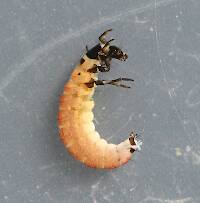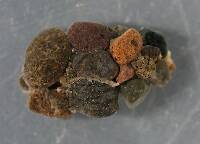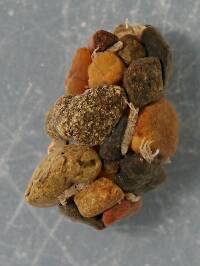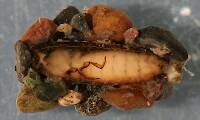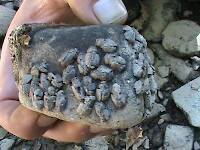
Hex Mayflies
Hexagenia limbata
The famous nocturnal Hex hatch of the Midwest (and a few other lucky locations) stirs to the surface mythically large brown trout that only touch streamers for the rest of the year.
Featured on the forum

This specimen keys pretty easily to Onocosmoecus, and it closely resembles a specimen from Alaska which caddis expert Dave Ruiter recognized as this genus. As with that specimen, the only species in the genus documented in this area is Onocosmoecus unicolor, but Dave suggested for that specimen that there might be multiple not-yet-distinguished species under the unicolor umbrella and it would be best to stick with the genus-level ID. I'm doing the same for this one.

Troutnut is a project started in 2003 by salmonid ecologist Jason "Troutnut" Neuswanger to help anglers and
fly tyers unabashedly embrace the entomological side of the sport. Learn more about Troutnut or
support the project for an enhanced experience here.
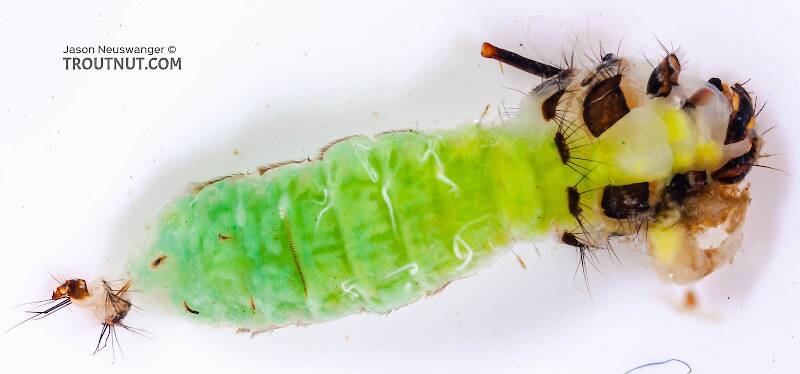
The green blob contained in this case is a pupa in the early stages of transformation from larva to the final stage we generally picture and imitate. This specimen and several like it were fixed to a rock I picked up, and each one had the front of its case sealed off, protecting the helpless pupa from predation. It's neat to see the insect part-way through such a radical transformation.
It was very hard to extract this thing from its case, so there's a bit of extra goo near the head from where I accidentally punctured it.
It was very hard to extract this thing from its case, so there's a bit of extra goo near the head from where I accidentally punctured it.
Martinlf on Apr 23, 2007April 23rd, 2007, 1:27 am EDT
Jason, great photos. This is what I expect a Grannom and its case to look like. It's clear to me that the bugs I mention in my previous post aren't Grannoms. Their cases aren't nearly so neat, as David notes Grannoms should be, and they aren't shaped at all like the cases you posted above. I think Roger is on to something with his photos, and Quill Gordon has given some likely suspects for PA.
"He spread them a yard and a half. 'And every one that got away is this big.'"
--Fred Chappell
--Fred Chappell
CaseyP on Apr 23, 2007April 23rd, 2007, 3:13 am EDT
wow--perfect timing: i tied some pupae last night and wondered about the color and size for the grannoms, and you've answered both questions without a single word.
now i need words: how do the little things construct those perfectly rectangular homes? do they trim the materials somehow? i can't wait for a video of a home-building caddis! would they survive a typical home aquarium or do they need cold running water?
now i need words: how do the little things construct those perfectly rectangular homes? do they trim the materials somehow? i can't wait for a video of a home-building caddis! would they survive a typical home aquarium or do they need cold running water?
"You can observe a lot by watching." Yogi Berra
Taxon on Apr 23, 2007April 23rd, 2007, 4:01 am EDT
how do the little things construct those perfectly rectangular homes? do they trim the materials somehow?
Don't recall ever reading an answer to that question, nor have I been in a position to observe. However, it's reasonable to assume they attach sticks of sufficient dimension, and then chew the sticks down to perfect length once attached. Would be interested to see whether the stick-trimming is a batch process, or whether they trim each stick as soon as attached. As I recall, pioneers used the former method for constructing their log cabins.
Martinlf on Apr 23, 2007April 23rd, 2007, 4:06 am EDT
Casey, a deadly Grannom pupa imitation is a peacock-bodied soft hackle wet fly. Twist the peacock herl around your thread before wrapping it to reinforce the fragile herl. I use a turn or two of dark dun hackle, and rib the body with green or chartreuse wire for further strength. Dead drift it on the bottom like a nymph when Grannoms are hatching. I almost got my arm put in a sling doing this Saturday. I'm also going to tie up some of Gonzo's pupa for more educated fish, but the peacock fly is very quick to tie, and works well on most Grannom-eating fish if they are not taking anything on top.
"He spread them a yard and a half. 'And every one that got away is this big.'"
--Fred Chappell
--Fred Chappell
Martinlf on Apr 23, 2007April 23rd, 2007, 4:08 am EDT
Roger, you type faster than I do. I was amused to see your post had popped up when I submitted mine. :)
I'd bet they do it a stick at a time, but would be delighted to be proven wrong.
I'd bet they do it a stick at a time, but would be delighted to be proven wrong.
"He spread them a yard and a half. 'And every one that got away is this big.'"
--Fred Chappell
--Fred Chappell
CaseyP on Apr 23, 2007April 23rd, 2007, 9:18 am EDT
thanks, guys. those pioneers cut the timber before assembly so as not to lift any more than necessary. if i were a wee insect working in a river current, i'd cut, then glue, too! imagine, though: that procedure requires a tiny brain to always cut it exactly the right length. that is the miracle!
Louis, i'll tie some of those peacock numbers tonight. saturday i floated just everything down low, and hooked only one. i need to match the inhabitants' current condition more closely, for sure. the body should be plump, right?
Louis, i'll tie some of those peacock numbers tonight. saturday i floated just everything down low, and hooked only one. i need to match the inhabitants' current condition more closely, for sure. the body should be plump, right?
"You can observe a lot by watching." Yogi Berra
Martinlf on Apr 23, 2007April 23rd, 2007, 3:21 pm EDT
Casey, yes, use the bigger peacock herls; they will make a plump body.
"He spread them a yard and a half. 'And every one that got away is this big.'"
--Fred Chappell
--Fred Chappell
LittleJ on Apr 25, 2007April 25th, 2007, 3:22 pm EDT
just another pattern to try would be the peeking caddis eric stroup ties in his video w/charlie meck . I just sub'd the white sparkle yarn for green sparkle yarn. It was deadly before the hatch started. I then switched to a peacock soft hackle once the hatch was in progress.
Jeff
Jeff
Martinlf on Apr 26, 2007April 26th, 2007, 1:28 am EDT
Jeff, I have that video and will take a look. Thanks. Hope you are doing well on the J. I haven't made it over that way yet this season.
"He spread them a yard and a half. 'And every one that got away is this big.'"
--Fred Chappell
--Fred Chappell
LittleJ on Apr 26, 2007April 26th, 2007, 2:38 pm EDT
Louis
The "j" has been fishing well...when the waters been down. The grannom hatch was fantastic. The caddis pattern was on volume 2, and I also forgot to mention a few other things I do different : first I downsize the bead on the hook so that you can taper the "case" up to the larva better,2nd I was wrapping the dubbing tight not using a loop to make it spikey. I think that makes it look more like the pyramid shaped cases we have up here. I don't know if they are the same everywhere or not.
Jeff
The "j" has been fishing well...when the waters been down. The grannom hatch was fantastic. The caddis pattern was on volume 2, and I also forgot to mention a few other things I do different : first I downsize the bead on the hook so that you can taper the "case" up to the larva better,2nd I was wrapping the dubbing tight not using a loop to make it spikey. I think that makes it look more like the pyramid shaped cases we have up here. I don't know if they are the same everywhere or not.
Jeff
Martinlf on Apr 27, 2007April 27th, 2007, 5:24 am EDT
Jeff, it's my understanding that the hatch moves up the river, so I may try some of the upper river this weekend or next week if the hatch is still on and the water levels are good. Thanks for the tying tips.
"He spread them a yard and a half. 'And every one that got away is this big.'"
--Fred Chappell
--Fred Chappell
Creno on Dec 22, 2007December 22nd, 2007, 11:08 am EST
One note - most would consider this a pre-pupa or really a larva. The larval sclerites are what you see splitting as the immature pupae starts to shed the larval skin. This form would seldom be available in the drift although out here trout will simply tear the cases from the rocks/sticks to which the larva has attached the case while pupating.
The discussion of case making is fascinating. I can't place my hands on the article but I remember a discussion about the critter simply stretching the stick out to the end of its legs (like your mother used to measure a yard of cloth) and clipping it off. As the critter grows, so grows the length of the stick and thereby maintianing that neat taper.
If the above case making information is correct then critters like Pycnopsyche must have a severe case of the shakes.
The discussion of case making is fascinating. I can't place my hands on the article but I remember a discussion about the critter simply stretching the stick out to the end of its legs (like your mother used to measure a yard of cloth) and clipping it off. As the critter grows, so grows the length of the stick and thereby maintianing that neat taper.
If the above case making information is correct then critters like Pycnopsyche must have a severe case of the shakes.
Martinlf on Dec 22, 2007December 22nd, 2007, 1:45 pm EST
Creno, glad to see you posting here and adding information. You'll find a good-natured bunch on the site, as most of the posts you have been reading should demonstrate.
"He spread them a yard and a half. 'And every one that got away is this big.'"
--Fred Chappell
--Fred Chappell
Taxon on Dec 25, 2007December 25th, 2007, 2:49 pm EST
Creno-
I too am happy to see you posting here. You seem to be a good source for some of the kind information I find extremely interesting, but which can be somewhat elusive to find.
Whenever you have information that you are motivated to share, don't feel constrained to provide it in conjunction with an ongoing thread, as most of us have a lot to learn and are eager for each opportunity. Also, some us learn by seeing as well as by hearing, so don't be bashful about posting photos or illustrations.
A Merry Christmas to you and yours,
I too am happy to see you posting here. You seem to be a good source for some of the kind information I find extremely interesting, but which can be somewhat elusive to find.
Whenever you have information that you are motivated to share, don't feel constrained to provide it in conjunction with an ongoing thread, as most of us have a lot to learn and are eager for each opportunity. Also, some us learn by seeing as well as by hearing, so don't be bashful about posting photos or illustrations.
A Merry Christmas to you and yours,
Martinlf on Mar 21, 2010March 21st, 2010, 6:37 am EDT
Dan's suggestion for extracting Grannom larvae may be helpful.
"He spread them a yard and a half. 'And every one that got away is this big.'"
--Fred Chappell
--Fred Chappell
Quick Reply
Related Discussions
Topic
Replies
Last Reply
0
Mar 23, 2010
by Troutboomer
by Troutboomer
2
Feb 15, 2013
by Troutnut
by Troutnut





